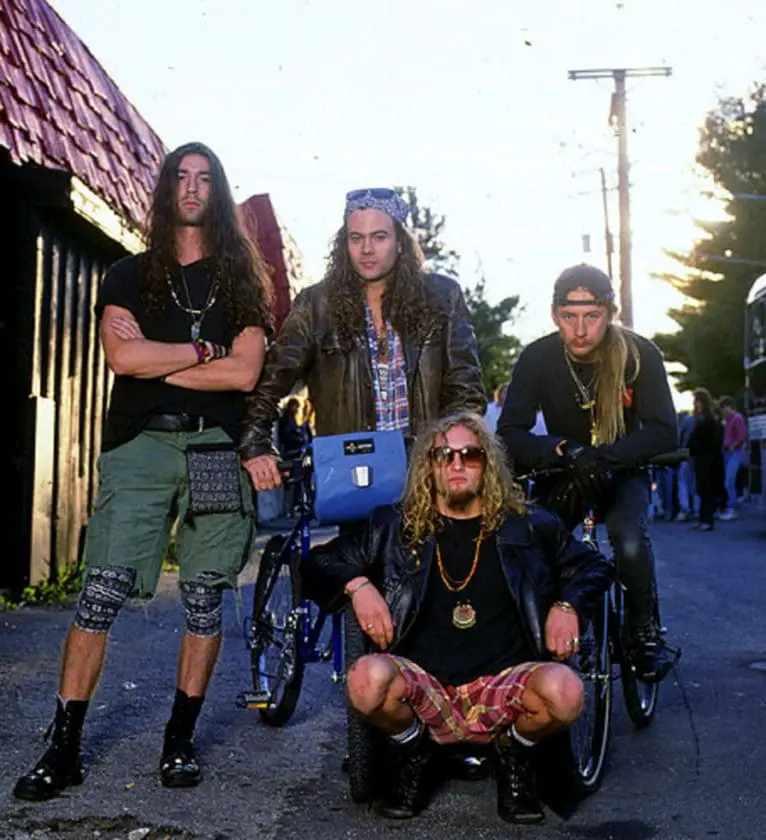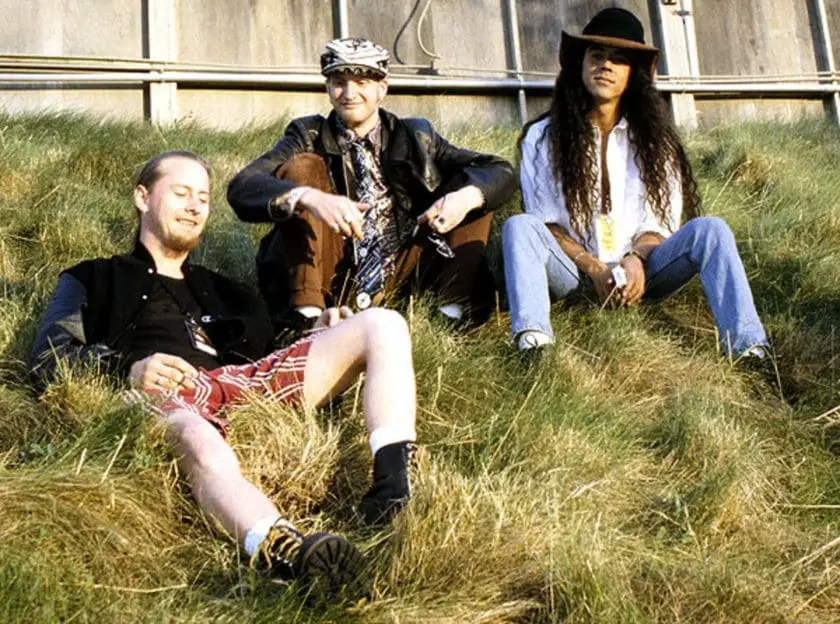On August 21st 1990 Facelift was released and the world was introduced to Alice in Chains, and the incredible vocals of Layne Staley.

The release coincided with a movement in the pacific Northwest, sometimes known as ‘the Seattle sound’ but perhaps more commonly referred to as Grunge (although the band would distance themselves from being pigeonholed by such a label). Bands such as Mother Love Bone, Nirvana and Soundgarden had already made ripples across the country with their brand of anti-establishment rock music taking elements of punk, metal and blues and fusing them in to a swirling, expanding compound that broke apart the hair metal scene preceding it.
There was a sense that the good-time, party-hit, pop-rock bands that had dominated the 80s charts were not sonically representative of Ronald Reagan’s America. Punk had been relegated back to the underground after rearing its head in the previous decade, and bands spouting themes of excessive substance abuse and promiscuity seemed to almost distract from the rampant crises of the war on drugs and AIDS, not to mention the continuing troubles of the Cold War.
It could be said that the 80s was the era of the gimmick in music, and its superficial nature would ultimately be its own downfall. There was a lot of anger harbored amongst the youth across the country who felt continuously ignored or downtrodden as pockets of the communities they were growing up in were being savaged by crime, poverty and other social issues.
This is all a huge part of what made Seattle the centerpiece of an entire musical movement. A community of musicians ready to write about authentic, no-BS topics had emerged; a community who all knew each other and seemingly jammed together and frequently traded band members. A community who would forever be associated with the Seattle sound and who would go on to tour together, enjoy massive commercial success together, and unfortunately all too commonly grieve with each other over comrades lost along the way to all-too-familiar scenarios.
Alice in Chains were one of the bands to break the mold in the Northwest. We Die Young had been a hit on local metal radio stations before Facelift was released. Once the album dropped, the world got a sense of the best thing about the band, which was their diversity and willingness to not conform to a single way of song writing. There are portions of the album which are dark, but it then transcends into groovy up-tempo numbers.
A typical example of this is the opening track We Die Young, a dark, brooding number about teenage drug use being followed by the talk box driven Man in the Box, a song to this day able to get a crowd jumping. There are songs with no recognizable choruses. Others change tempo mid-track. It’s a total mixed bag.
While Jerry Cantrell’s skillful song writing was the key ingredient to making this album as huge as it was, it arguably would not have achieved such success without the vocal style Layne Staley brought to the mix. His unique vocal style spawned a technique known as ‘Yarling’, a style which would be used by many vocalists for years to come. Layne Staley offered a unique quality that no one else in the scene had captured. His powerful screech-like vocal style projected pitch-perfect high and low notes, all belted at the top of his lungs.
He had the ability to convey a haunting quality with his vocals, sometimes eerie but also vulnerable, as though verbalizing some sort of demon within – something which would only grow stronger later in his career. His style quickly made him one of the most recognizable vocalists in rock, and along with the excellent harmonies complimented by Jerry Cantrell the band would go on to have a worldwide impact. Unfortunately, as what seems to be the case all too often, this would lead Layne down a dark road and into a dark chasm from which he would never climb out.
Their next EP Sap was a nice stop-gap between full length releases. It showcased a more intimate side to the band and was largely acoustic. The band worked with Heart’s Ann Wilson as well as fellow grunge vocalists Chris Cornell of Soundgarden and Mark Arm from Mudhoney (billing their collaboration on the track ‘Right Turn’ as Alice Mudhoney of course). The EP would eventually hit gold and cement Alice In Chains as more than just a hard rock band capable of pulling surprises from an arsenal of talent; it would prove to be a teaser for what was to come.

Dirt is when the band shifted towards a depth of darkness seldom heard from other hard rock bands. Released on September 24th 1992, we can immediately identify the themes of depression, isolation, pain, anxiety and loss throughout. It is a lesson in how to perfectly capture psychological ailments and express them in the form of song. It was around this time when Layne really showed the world just how he wore his heart on his sleeve.
In tracks such as Down in a Hole he vocalizes a torture within and a sense of hopelessness, despite the success he has found. One of the most interesting tracks is Junkhead, where Layne documents his own drug habit. It is truly the sound of a man in denial at the height of his drug use. There is an air of arrogance and carelessness, and an obvious sadness present in this track – you can definitely see the true point at which Layne Staley was lost to the world. Even though he would live another ten years, drugs such as heroin and crack cocaine would go on to dictate his life.
You can’t understand a user’s mind
But try, with your books and degrees
If you let yourself go and opened your mind
I’ll bet you’d be doing like me
And it ain’t so bad
What’s my drug of choice?
Well what have you got?
I don’t go broke
And I do it a lot
Regardless, Dirt is a masterpiece. Layne’s vocal technique was improved further by using different layering techniques. With the help of Jerry’s solid harmonies, Dirt was truly the album that gave Layne Staley recognition as one of the best vocalists in rock. The album would go on to be the band’s most successful, going platinum four times in the US alone. It would prove to be the benchmark for a new wave of artists ready to emulate the style the band had created. However, none would ever really come close.
It was around then that the drug abuse surrounding the band had been amped up. While for the moment the band largely held it together, it would cost them their bassist Mike Starr, allegedly be kicked out due to excessive heroin use. (Incidentally, Mike Starr would go on to detail on a 2009 edition of Celebrity Rehab that he was the last person to see Layne Staley alive. Starr died of a drug overdose himself in 2011.)
After the immense success of Dirt, the released their second acoustic-based EP Jar of Flies featuring with new bass player Mike Inez. Once again, the band showed their depth with harrowing tracks such as Nutshell and Rotten Apple, the lyrical content bearing soul, woe and disdain. I Stay Away and No Excuses set a lighter tone for the first time since Facelift. Jar of Flies was the first ever EP to top the Billboard 200 chart and was the band’s first release to reach such a peak. This is something that was only repeated once later by Linkin Park and Jay-Z’s collaborative Mashup EP Collision Course.
Since its release on January 25th 1994, the EP has gone on to be certified 3x Platinum in the US, making it their second most successful release. Overall, the EP feels like a journey through the dark and light sides of the band, Layne’s vocals being a prominent guide through a complex range of emotion, expressed in a uniquely beautiful way that compliments the music (just like every release he has featured on). It was around this time that Layne Staley entered rehab for his drug addiction but he would relapse in the run up to a summer tour supporting Metallica.
He would continue using drugs until the day he died. It was shortly after the release of the album that Kurt Cobain of Nirvana was found dead after apparently committing suicide with a shotgun. By eerie coincidence, the two vocalists share the same death date of April 5th, albeit 8 years apart.
Alice in Chains did not release another full length album until towards the end of 1995. In the meantime, Layne had joined supergroup Mad Season along with Mike McCready of Pearl Jam, Barrett Martin of Screaming Trees and John Baker Saunders of The Walkabouts. The band’s only album Above was more a more straightforward blues/rock effort and largely lower in tempo than any of the members’ respective bands had dabbled in previously.
It was composed in around ten days – the music for the album was finalized before Layne Staley had joined the band. The album was well-received and accredited gold. The supergroup was short-lived though, and went on hiatus before the summer of 1995 to allow each member to focus on their primary bands.
Layne Staley’s substance abuse has been cited as one of the reasons the group did not extensively tour and John Baker Saunders would die of an overdose in 1999. Efforts to rekindle the band without Staley and Saunders were made in 2013 when Above was re-released including additional tracks recorded with Mark Lannegan (Screaming Trees, Queens of the Stone Age) as bonus material. Reunion shows with Chris Cornell (Soundgarden) on vocals and Duff McKagan (Guns n Roses, Velvet Revolver) took place in 2015, with new music from this incarnation of the band proposed for future release.
On November 7th 1995 Alice in Chains released their self-titled album, the last album to feature Layne Staley on vocals. During the writing and recording of the sessions it is said that Layne’s addiction to heroin had become a major issue, as he would regularly go missing for days and fall asleep during band meetings. The sense of discomfort within the band is evident on the album itself, as while the band attempted to pursue a more mature sound (diverting away from the sludge-style of Dirt), there is a definite feeling that the natural cohesion that they once displayed was now replaced with a forceful effort to simply try and produce a palatable album.
While the self-titled album is decent in its own right, one wonders what could have been produced if all members were firing on all cylinders rather than fighting over issues that would ultimately tear the foundation of the band apart. They did not tour in support of the self-titled album due to Layne’s addictions, and any efforts he made to get clean were now nothing more than an exercise in futility.

The band agreed to do a live performance of MTV’s Unplugged in April 1996, a show which had become popular due to the unique acoustic versions of songs bands would play. This was Alice in Chains’ first performance in over two years. If the world was not savvy to Layne Staley’s addictions by this point, it would be heartbreakingly showcased during this performance – on numerous occasions he forgets the words despite having a lyric sheet in front of him. He wears black sunglasses to cover red and glazed eyes and looks physically weak. While he manages to sing exquisitely for much of the performance, it is essentially like watching a man fading away before your eyes.
The band did agree to open for the recently reunited Kiss later in the year, though the stint only lasted four shows. On July 3rd 1996, the band played their last ever show with Layne Staley in Kansas City, Missouri. After the show, he was found unresponsive having overdosed on heroin, and while he recovered from this particular incident it proved to be the final straw. Alice in Chains would not perform live again for nearly 10 years.
Despite recording a few tracks in 1998, Layne Staley kept out of the public eye almost completely in between the time of his last show and his death. It was said anyone close to him could see he had physically deteriorated, at times looking pale and skinny. His addiction to drugs had completely consumed him – by this point he was essentially the walking dead. He had relinquished all traits of the person he used to be. Tragically, Layne Staley’s body was found on April 19th 2002, two weeks after he had died. Various drug paraphernalia surrounded the body. At the time of death he was estimated to have weighed as little as 80 pounds.
It is a always great shame to lose such a powerful vocalist in such a way. Layne Staley had an incredible ability to cast shadows through his voice. His haunting, brooding vocals made him one of the very best singers to grace rock music. The music he made with Alice in Chains (and briefly Mad Season) is timeless and can quite often be attributed to a unique cultural impact that, along with other Seattle-based bands, helped influence a new generation of musicians. His vocal style has been emulated time and time again but exact replication is simply impossible.
While Alice in Chains have since reformed with vocalist William DuVall (a fantastic singer in his own right), the band no longer have the same visceral aggression. The lyrical content is also much different – the new direction of the band offers a fresh outlook. The impact Layne Staley had surely makes him a candidate for a future rock n roll hall of fame induction, along with the rest of the band. It is a shame that two members of such an important band could be taken by the same addiction, but it is important to remember them for the art they created and not just the painfully sad way their lives ended.
Their deaths illuminate a significant issue that many musicians and other artists face. A tortured artist will often be plagued by demons until they succumb way to escape reality. Often mainstream success itself can affect someone’s mental health, creating a black cloud that follows them around. This is why it is of vital importance that we look back on the music that artists such as Layne Staley created and understand the message they are trying to convey. While art is a form of entertainment, it is often the only outlet someone may have to express their pain.
I recommend that anyone take time to look at Layne-Staley.com, which has a dedicated section for donations towards the Layne Staley memorial fund. The charity provides treatment, education and help with recovery from substance addiction.
RIP Layne Staley
August 22nd 1967 – April 5th 2002


